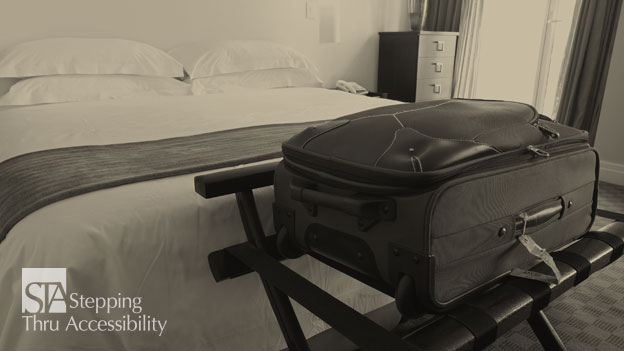Blog
Return to Blog »
Janis Kent, Architect, FAIA, CASp © August, 2015 Aside from hotels, motels, and inns there are other types of vacation rentals that people use. Some fall under the definition of bed and breakfasts while others are considered short-term private rentals where people rent out their homes, or rooms within their homes whether thru an agent or thru online companies such as Airbnb. The latter has become quite controversial with its growing impact on the market in terms of what codes to follow for construction, whether taxes are paid similar to transient lodging, and in general, being in competition with the more traditional types of transient lodging. The main question I would like to address is Access and what are the requirements under the ADA Standards for privately owned facilities. The definition of a place of lodging, as one of the types of Places of Public Accommodation, is as follows and this definition is adopted in the California Building Code (CBC) as well; (1) Place of lodging, except for an establishment located within a facility that contains not more than five rooms for rent or hire and that actually is occupied by the proprietor of the establishment as the residence of the proprietor. For purposes of this part, a facility is a “place of lodging” if it is— (i) An inn, hotel, or motel; or (ii) A facility that— (A) Provides guest rooms for sleeping for stays that primarily are short-term in nature (generally 30 days or less) where the occupant does not have the right to return to a specific room or unit after the conclusion of his or her stay; and (B) Provides guest rooms under conditions and with amenities similar to a hotel, motel, or inn, including the following— (1) On- or off-site management and reservations service; (2) Rooms available on a walk-up or call-in basis; (3) Availability of housekeeping or linen service; and (4) Acceptance of reservations for a guest room type without guaranteeing a particular unit or room until check-in, and without a prior lease or security deposit. Bed and Breakfasts Private Rentals Combination Residential and Transient Lodging In summary, which codes and regulations apply depends on what the intention the units are designed for in new construction – residential use and/or transient lodging. For existing and for alterations, the ownership of the individual unit and whether the owner has substantial control over the interiors will have an impact. For bed and breakfasts, whether new or existing, the number of rental rooms and whether the proprietor lives there will have impact on whether it is considered under the definition of transient lodging. And we should not forget the requirements of FHA for adaptable units if it is not considered transient lodging or if it is considered a combination of housing and transient lodging. Thanks to D. Corelis and J. Abrams for the topic request. If you have a topic you’d like to request, please email me. Be aware that your local City or County may have additional requirements that are more restrictive than the State or Federal requirements. Also, this article is an interpretation and opinion of the writer. It is meant as a summary – current original regulations should always be reviewed when making any decisions. © Janis Kent, Architect, FAIA, CASp 2015What is Not Transient Lodging – Alternatives & Access

Bed and Breakfasts are somewhat straight-forward. If the facility has 5 rooms maximum for rent AND the proprietor lives at the facility as their place of residence, then by definition, the facility is not considered transient lodging per item #1 above since it does not fall under the definition of a Place of public accommodation. Therefor, bed and breakfast facilities are not required to meet Accessibility requirements under the ADA Standards, although if there are 4 or more units on the ground floor, it may very well be covered under FHA. If the proprietor does not live there and there are 5 or less rooms for rent, or if the proprietor does live there but there are more than 5 rooms for rent, then the bed and breakfast might fall under the same requirements as transient lodging in terms of Access for parking, guest rooms (both mobility and communication features), common space, accessible routes, and readily achievable Barrier Removal if it is an existing facility. This would depend upon whether it meets both criteria (A) and (B) from the definition above.
Short term private rentals are a bit more complex as to interpretation but they are becoming more prevalent as a vacation rental. Generally these would not meet criteria B(2) thru B(4) listed above and most do not meet the other criteria under (B) of the ADAS (and CBC) per definition for a place of lodging. So this type of vacation rental would generally not fall under the Access requirements of ADA and neither would there be any requirements for Barrier Removal. Another item is, the 2010 ADAS has an exception that if a property has its interiors substantially controlled by its individual owner, although it may be rented out by an entity that owns, leases, or operates the overall facility, there is an exception for compliance with the ADAS alterations and Barrier Removal requirements as well.
There are also some hybrid building types where there are a combination of housing and transient lodging in the same facility. Units that are designed to be transient lodging only would need to comply with ADA (and CBC 11B). Rooms that are residential only would be required to comply with FHA if they are considered covered units (and CBC 11A). Units that are designed and constructed so they could be used either as residential and/or transient lodging would need to comply with both ADAS and FHA (and CBC 11A for residential and CBC 11B for transient lodging). And this would have impact on condominiums and time shares as well.